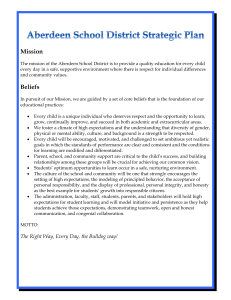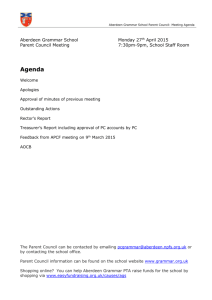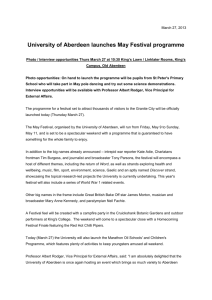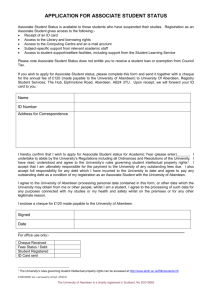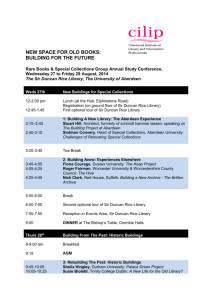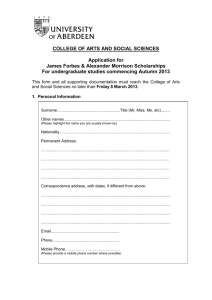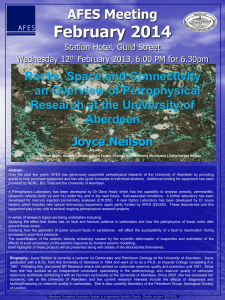Cultural Engagement Strategy
advertisement
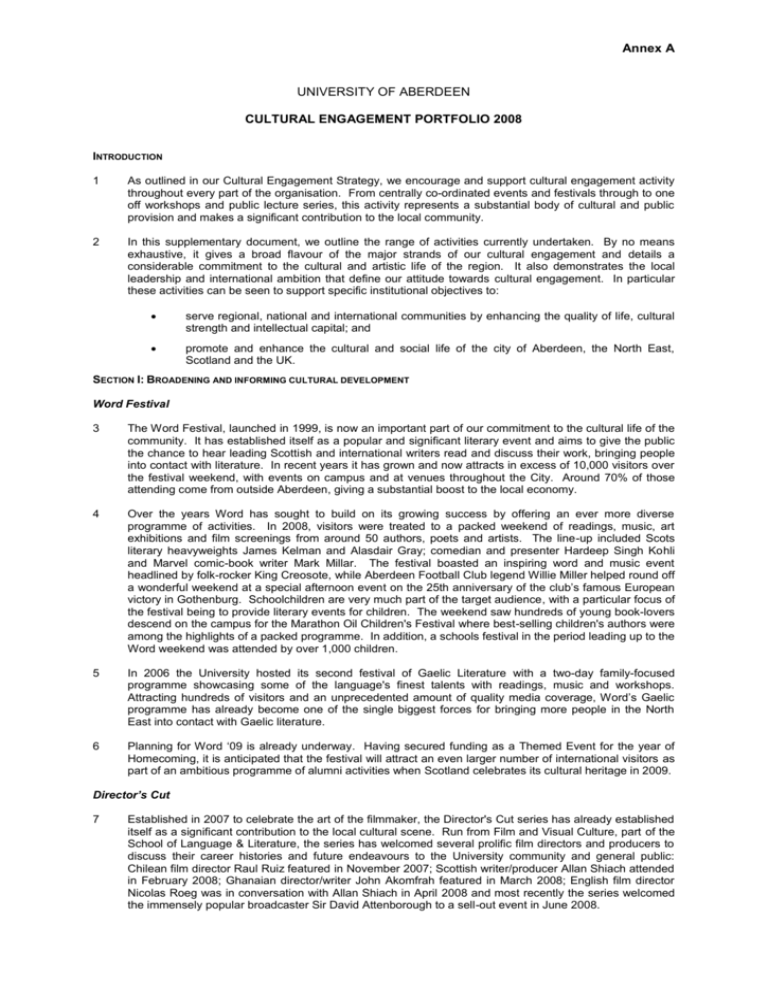
Annex A UNIVERSITY OF ABERDEEN CULTURAL ENGAGEMENT PORTFOLIO 2008 INTRODUCTION 1 As outlined in our Cultural Engagement Strategy, we encourage and support cultural engagement activity throughout every part of the organisation. From centrally co-ordinated events and festivals through to one off workshops and public lecture series, this activity represents a substantial body of cultural and public provision and makes a significant contribution to the local community. 2 In this supplementary document, we outline the range of activities currently undertaken. By no means exhaustive, it gives a broad flavour of the major strands of our cultural engagement and details a considerable commitment to the cultural and artistic life of the region. It also demonstrates the local leadership and international ambition that define our attitude towards cultural engagement. In particular these activities can be seen to support specific institutional objectives to: serve regional, national and international communities by enhancing the quality of life, cultural strength and intellectual capital; and promote and enhance the cultural and social life of the city of Aberdeen, the North East, Scotland and the UK. SECTION I: BROADENING AND INFORMING CULTURAL DEVELOPMENT Word Festival 3 The Word Festival, launched in 1999, is now an important part of our commitment to the cultural life of the community. It has established itself as a popular and significant literary event and aims to give the public the chance to hear leading Scottish and international writers read and discuss their work, bringing people into contact with literature. In recent years it has grown and now attracts in excess of 10,000 visitors over the festival weekend, with events on campus and at venues throughout the City. Around 70% of those attending come from outside Aberdeen, giving a substantial boost to the local economy. 4 Over the years Word has sought to build on its growing success by offering an ever more diverse programme of activities. In 2008, visitors were treated to a packed weekend of readings, music, art exhibitions and film screenings from around 50 authors, poets and artists. The line-up included Scots literary heavyweights James Kelman and Alasdair Gray; comedian and presenter Hardeep Singh Kohli and Marvel comic-book writer Mark Millar. The festival boasted an inspiring word and music event headlined by folk-rocker King Creosote, while Aberdeen Football Club legend Willie Miller helped round off a wonderful weekend at a special afternoon event on the 25th anniversary of the club’s famous European victory in Gothenburg. Schoolchildren are very much part of the target audience, with a particular focus of the festival being to provide literary events for children. The weekend saw hundreds of young book-lovers descend on the campus for the Marathon Oil Children's Festival where best-selling children's authors were among the highlights of a packed programme. In addition, a schools festival in the period leading up to the Word weekend was attended by over 1,000 children. 5 In 2006 the University hosted its second festival of Gaelic Literature with a two-day family-focused programme showcasing some of the language's finest talents with readings, music and workshops. Attracting hundreds of visitors and an unprecedented amount of quality media coverage, Word’s Gaelic programme has already become one of the single biggest forces for bringing more people in the North East into contact with Gaelic literature. 6 Planning for Word ‘09 is already underway. Having secured funding as a Themed Event for the year of Homecoming, it is anticipated that the festival will attract an even larger number of international visitors as part of an ambitious programme of alumni activities when Scotland celebrates its cultural heritage in 2009. Director’s Cut 7 Established in 2007 to celebrate the art of the filmmaker, the Director's Cut series has already established itself as a significant contribution to the local cultural scene. Run from Film and Visual Culture, part of the School of Language & Literature, the series has welcomed several prolific film directors and producers to discuss their career histories and future endeavours to the University community and general public: Chilean film director Raul Ruiz featured in November 2007; Scottish writer/producer Allan Shiach attended in February 2008; Ghanaian director/writer John Akomfrah featured in March 2008; English film director Nicolas Roeg was in conversation with Allan Shiach in April 2008 and most recently the series welcomed the immensely popular broadcaster Sir David Attenborough to a sell-out event in June 2008. Aberdeen Music Prize 8 In 2005, in association with the BBC Scottish Symphony Orchestra, we introduced a biennial International Music Prize. Composers from around the world submit new works for string quartet, with five works selected and performed by members of the BBC Scottish Symphony Orchestra during a workshop weekend held in April. After the workshop and concert performance of all five pieces, one composer is offered The University of Aberdeen Music Prize - a cheque for £5,000 in the form of a commission for a new work for orchestra to be performed by the BBC Scottish Symphony Orchestra and broadcast on BBC Radio 3 the following year. Commissions were awarded in 2005 and 2007 and the competition will run again in 2009 when the prize weekend will move from April to November, forming a synergy with the timing of the ‘sound’ festival (see below). 9 Alongside the competition - the only one of its kind in Scotland – the Music Prize Weekend involves workshops, master-classes, talks and concerts linked with creativity, composition and self-expression. All of these are open to the public and in the past have been well supported with attendance from across the UK. In addition to the weekend of activities, a one day workshop ‘Compose!’ has developed, produced in conjunction with the AIYF. This allows younger composers, schoolchildren and students to benefit from workshops and performances of their work by judges and musicians involved with the Music Prize. Commissioning and exhibiting works 10 An important part of our commitment to cultural engagement activity is the creation of new works. Our Music Prize, ‘Compose!’ and the ‘sound’ festival all encourage the composition of new musical works, while in literature, the Elphinstone Institute (see below) has created a web-based resource, the Elphinstone Kist, to bring new and fresh writing in North East Scots to the attention of schools and the general public, with contributors ranging from established authors to schoolchildren. In 2007/08 ‘Picturing the Past’, a photographic competition run from our Department of Archaeology, was awarded a Cultural Engagement Grant and aims to produce an exhibition of amateur photography during session 2008/09. 11 At institutional level, we have adopted the practice of allowing 1% of the construction costs of new buildings to support the commissioning of new art works. For example, £500,000 has been allocated to the provision of art in two of our major building projects, with various sculptures and related works commissioned for the Matthew Hay building and due to be installed in 2009, with similar plans to commission art through open competition for the new Library. Works are also planned to mark the 500th anniversary of the consecration of King’s College Chapel and the creation of the new academic square, while we are working with artists to create a special exhibition relating to sport across the world to mark the opening, in 2009, of the Aberdeen Sports Village, our new joint venture with sportScotland and Aberdeen City. All of these projects will involve international as well as Scottish artists. 12 As part of this process, our Art Advisory Committee commissioned two sculptures that were delivered in 2006-07, one by Sam MacDonald and one by Steve Dilworth, and has commissioned a third by Kirsteen Pieterse. A fourth work by Kenny Hunter was installed last year and has been greatly admired. All of the artists are Scots and the works are displayed to the benefit of the local community around the campus. A further sculpture (Column to Drum by Ian Hamilton-Finlay) has been purchased and has been displayed in the Aberdeen Art Gallery as part of our town-gown cultural activities. 13 A painting by Steven MacIver, an emergent Scottish talent, has recently been commissioned and will be installed to celebrate our long association with Marischal College, while a series of smaller works by local artists have been purchased and installed in buildings across the campus. MacIver has also been commissioned to conduct an artistic and sporting odyssey along Latitude 41 to explore the importance of sporting venues to local communities around the world. The resultant work will be displayed in the new Aberdeen Sports Village; a project jointly funded by the University, Aberdeen City and sportScotland that will open in 2009. We have recently accepted paintings from Callum Innes and Victoria Crowe that are on display in public spaces in the University, while a collection of prints, owned by Barbara Rae, is now on long-term loan to the University. In parallel, we act as a partner to Aberdeen Art Gallery, displaying works of art from the Gallery in various University buildings, allowing the display of art that would not otherwise be accessible to the public. Elphinstone Institute 14 The Elphinstone Institute is dedicated to the research and study of cultural traditions in the North and North-East of Scotland. The Institute organises public lectures and events featuring music, song and readings as well as collaborating with other institutional and local partners on a wide variety of cultural projects in the region. Among the events organised by the Institute are a major short story competition, the Toulmin Prize, run as part of Word ’08; the annual Traditional Singing Weekend in partnership with Cullerlie Farm Park; and for 2009, partnership with Aberdeenshire Arts & Heritage to host ‘Your North East: The Heritage of the North-East”, a major conference for international visitors as part of Homecoming 2009. Alongside these activities the Institute supports the Elphinstone Kist, a web-based resource to bring 2 new and fresh writing in North East Scots to the attention of schools and the general public with contributors ranging from established authors to schoolchildren. 15 Since 2004 the Elphinstone Institute has worked in partnership with Aberdeenshire Arts & Heritage at Peterhead Maritime Heritage Centre on the Boaties Craft Workshop. This event will run again in 2008 and celebrates the building of ‘boaties ’, a model-making skill that dates back at least 150 years in North-East Scotland. Boaties are based on the traditional Scottish fishing boat known as the ‘fifie’ and sail without rudder, motor, or remote control, depending on the skill of the maker/owner to trim the boat and set the sails to match the conditions. Around 10,000 members of the public have visited the Craft Residency and Project Display in the four years since the project started, and 19 junior apprentices and 20 senior apprentices have been trained. As well as this, the Institute works closely with the Scottish Traditional Boat Festival at Portsoy and will, in 2009, partner the STBF in organising talks and demonstrations as part of its Homecoming programme ‘Traditional Boat Building, Design and Craft’. 16 Alongside these annual activities, the Institute is delighted to have established the North Atlantic Fiddle Convention. In 2001, the Institute ran the first in what has evolved into a successful, international series of North Atlantic Fiddle Conventions. It ran again in 2006, attracting several thousand local and international visitors, with nearly 100 international performers and academics contributing to an eclectic mix of concerts, workshops, jam sessions and dances. There are plans for another ‘home’ event in 2010, while in 2008 it travels on loan to Memorial University, St John’s, Newfoundland, Canada and in 2012 it will go to the Magee Campus of the University of Ulster, Derry. Research Institute of Irish and Scottish Studies 17 The AHRC Research Institute of Irish and Scottish Studies has established a partnership of three institutions – Aberdeen, Queen’s Belfast and Trinity Dublin – with unrivalled expertise in the fields of Irish and Scottish culture. It promotes high-quality single-discipline, comparative and interdisciplinary research, and undertakes postgraduate training with special reference to history, literary and cultural studies, and the languages of Ireland and Scotland, while in late 2007 it hosted a session of the Irish-Scottish Forum at which the interdependence of economic and cultural development was discussed. The Centre also offers a wide variety of events including lectures, seminars and conferences, all of which are open to the public. Material Culture and Exhibitions 18 We are responsible for the 6th largest collection of museum items of national and international importance in Scotland. We see the 7 museums and collections for which we are directly responsible as part of our key resources for outreach and cultural engagement. Our entire holdings were Recognised as being of National Significance by the Scottish Government in 2007. Our museums include the major displays of Marischal Museum and the Zoology Museum. The Marischal Museum collections, consisting of Scottish history & archaeology, non-Western ethnography, Fine Art, Numismatics and European & Mediterranean archaeology, are managed as part of the University’s Library & Historic Collections. The Anatomy Museum, the Pathology and Forensic Medicine collections and the University Herbarium are located within the College of Life Sciences and Medicine; and the Geological Collections and the Natural Philosophy Collection are located within the College of Physical Sciences. Our Historic Collections team provides curatorial support for the six science collections, and together the combined expertise delivers a range of services within the city and beyond. In 2006/07 we answered over 500 enquiries from the public and other researchers, and had over 106,000 unique visitors to our museum web pages. 19 The University is a member of the North East Museums Partnership, developing museum collections and services throughout Aberdeen City and Aberdeenshire. We have in post a full time school education officer to assist with the review and development of delivery across the North East, in partnership with similar new positions at Aberdeen City and Aberdeenshire Councils. We are also co-ordinating improvements in the access to collections throughout the north-east by developing internet search and resource discovery facilities. 20 Access to the Marischal Museum collections has been greatly enhanced by the development of the Marischal Virtual Museum. This is an on-line museum created as part of the LEMUR (LEarning with MUseum Resources) project, funded by JISC and the University and provides a full record of views, panoramas, captions and layouts of the museum galleries. It is underpinned by a database of thousands of objects, including all those on display, making it a rich resource for many purposes. A documentation project funded as a result of the Recognition of the collections is drawing together all collections onto a common database structure and will result in the web-mounting of a large proportion of the collections. 21 The Zoology Museum collection is the only large international collection of zoological specimens in the North of Scotland. The collection extends across most areas of zoology and is open to the public. The Natural Philosophy Collection of Historical Scientific Instruments has a permanent public display, and members of the public can also visit the Geology Collections and our large Herbarium by arrangement. Access to the Anatomy Museum and the Pathology and Forensic Medicine collections is restricted by the 3 Anatomy Act 1984 and the Human Tissues Act 1961 (as amended by the Human Tissue (Scotland) Act 2006) although items from these collections are used in events for schools and members of the public. Nearly 300 items from our collections were loaned to other museums and exhibitions during 2006/07. 22 The Cruickshank Botanic Gardens, which are open to the public, are partly owned and financed by the University, and partly by the Cruickshank Botanic Gardens Trust. Thanks to the support of The Friends of the Gardens, an exercise to catalogue the plants within the living collection of the Gardens has recently been completed. This has revealed the presence of over 2,500 different plant taxa - including members of over 450 different genera, and representatives of over 150 different plant families. The Friends of the Cruickshank Botanic Gardens also organise a lecture programme, open to members of the public. 23 We offer a wide variety of cultural and educational activities ranging from schools outreach to public engagement with our collections. The Natural History Centre (see also para 32) uses the Zoology Museum and the Cruickshank Botanic Garden to allow visitors, in particular children, to experience the living environment, through its extensive schools’ and families’ programme. Marischal Museum runs workshops for primary and secondary schools including object-handling workshops on the Picts and Vikings; the Romans; Senses, Old and New; Ancient Egypt; Scottish Prehistory; Materials; Drawing What You See; First Nations; Writing the Past; and Gender). In 2006/07, nearly 7,000 school pupils visited our collections and another 2,400 visitors took part in organised visits or events, with a total of 73,000 visits to our museums. In 2008 we held two massively successful Night at the Museum sessions for youngsters and their families and a sell-out series of behind the scenes tours of the collections. 24 Our museums also offer opportunities for work experience placements for school pupils and students, and volunteering. Regular volunteers include our own students and those of the Robert Gordon University, unemployed young people, and those using the opportunity to gain work experience and skills retraining. Volunteering also extends the opportunity for people to engage with our collections and their heritage. 25 We also maintain permanent exhibitions in the Marischal Museum, focussing on both the local history of the region and links with the wider world. The Encyclopaedia of the North East is the only permanent exhibition devoted to the character of this region of Scotland, while Collecting the World displays material from places as diverse as Egypt, New Guinea and Canada in an exhibition that explores the collecting activities of North-East people. Together these exhibitions display almost 3,000 objects. Our museum collections also run several programmes of temporary exhibitions, either major ones within our gallery spaces, or smaller ones at a number of locations around the university and at other locations e.g. the Forvie Centre, and the City’s Children’s Library. Items from the University’s collections are currently on display in no fewer than 24 public venues, and in 2006/07 we mounted 47 temporary exhibitions. Public lectures and research seminars 26 The University offers a range of public lectures across our entire research portfolio. From departmental research seminar series’ open to the public and the annual Christmas lecture in science and engineering for schoolchildren through to the high profile Inaugural Lectures, these events provide opportunities for academic research to be aired and challenged in a public arena. This public discourse is a vital strand of our commitment to lifelong learning and provides an outlet for the practical dissemination of research findings that lies at the heart of our knowledge transfer vision. 27 In addition to the various departmental seminars, the following lecture series are of particular note: Inaugural Lectures: In 2006 we launched an Inaugural Lecture series to promote our investment in new chair appointments. The series ran again in late 2007, with 6 lectures showcasing pioneering work being carried out in each of our three colleges. Planning for 2008/09 is underway. These events are open to members of the public. Marischal Museum Lectures: During term Marischal Museum hosts public lectures most Tuesday evenings. These include lectures by the Society of Antiquaries of Scotland, the Elphinstone Institute, Egyptology Scotland and the Aberdeen Scottish Hellenic Society. The Museum also hosts a variety of events, workshops, lectures and conferences through the year. In 2006/07 our museums ran 40 public lectures, talks and other special events attended by 4,400 people. Gifford Lectures: A prestigious public lecture series established in 1888 for the discussion of Natural Theology in the four Scottish ancient Universities, this series is seen as the foremost intellectual event in the matter of philosophy and religion. In 2009, we welcome Alister McGrath, Professor of Historical Theology from the University of Oxford to become the latest Gifford scholar. Geddes Harrower Chair in Greek Art & Archaeology: We are in the process of finalising a threeyear programme to bring renowned scholars in the field of Greek and Byzantine studies to Aberdeen to fill this visiting professorship, established in 1960. Alongside public lectures, and seminars, these visits involve collaboration with the Aberdeen Scottish Hellenic Society. They also 4 create the opportunity to showcase objects from the Museum collection in connection with rare published sources from our Special Collections. Res Musica: Is the Research Seminar Series run by Music in the School of Education. This attracts performers, composers and musicologists from the UK and abroad. Their presentations are open to the general public and are often tied in with performances as part of the University Concert Series or the ‘sound’ festival. Centre for Lifelong Learning 28 Our Centre for Lifelong Learning is committed to widening access and opportunities to learning for all. In order to achieve this, we offer a range of courses allowing those without previous qualifications to undertake study. In addition, for those less intent on formal study, we offer a series of capacity and confidence building sessions, personal development seminars as well as our popular evening lectures programme across the North of Scotland. However, we are aware that for many people, returning to study is a huge step, let alone doing so at University. We are therefore currently in discussion with adult learning co-ordinators based in various communities in the City to look at ways of delivering courses within local community settings and are actively engaged with the Community Learning and Development Strategies within Aberdeen City, Aberdeenshire and the Highlands and Islands 29 Under the auspices of the Centre for Lifelong Learning, we offer an extensive evening programme of talks and seminars at centres locally and throughout the Highlands and Islands. Wherever possible, the programme is developed in association and consultation with local societies and field clubs and as such feeds into a network of events designed to promote and safeguard our rich cultural heritage. Responding as they do to local requests, these lectures focus on exploring the rich and diverse culture of the Highlands and Islands and often act as the starting point for local research projects. 30 In 2007/08, the evening class programme delivered 113 lectures at 44 venues attended by over 2000 members of the public. When delivered as they are in association with local communities, the lectures are embedded as part of local life. Delivered in some of the remotest corners of Scotland, this lecture series forms a vital part of our commitment to cultural and community engagement in an area that stretches from Aberdeen via Orkney to St Kilda. Public engagement with science 31 Public engagement with science is seen by the University as one of the most important ways of enabling the public to experience and participate in the wider ‘culture’ of a research intensive University. This belief has led to the appointment, with effect from August 2008, of an officer dedicated to the development of the University’s public engagement with science strategy and to support the already extensive range of science outreach and engagement programmes we are involved in. 32 Through our Natural History Centre (NHC) – recently awarded EcoCentre status - we support a widerange of public and schools science engagement programmes. In 2007 a series of schools events celebrated the 300th birthday of Carl Linnaeus, the scientist responsible for the taxonomy of plants and animals. In 2008 the NHC’s summer schools programme entitled Planet Plant will be run at the City’s Duthie Park - the third successive year this venue has hosted this event. It will examine the important role of plants in society with a variety of sessions giving participants the chance to explore their uses from food to medicine. In connection with the summer programme, schools have participated in science-art competitions on the same theme. In addition to these events, regular facilitated sessions throughout the year allow youngsters of all ages to gain hands on experience with exhibits from our zoological and botanical collections. 33 The University also participates in a wide range of local and national events, such as National Science and Engineering Week and TechFest. The latter is the only annual Festival of Science, Technology, Engineering and Mathematics staged in Aberdeen and the North East of Scotland and is open to children and adults of all ages. The University has a strong link with the local science centre – Satrosphere – with one of our Vice Principals chairing its board and playing an active role in its progress. 34 In 2008 the link between culture and science was further reinforced by the award of a Cultural Engagement Grant to a project designed to raise awareness of oral health. Through the use of high impact microCT images of children’s teeth that will be displayed at dental surgeries in the local area, the project combines science and art with an informative narrative that will help raise oral health awareness. 35 Alongside these activities, a number of programmes more directly linked to recruitment can also be seen to enhance engagement with science. Scientists from across the University’s research portfolio are actively involved in giving talks about their latest research at a variety of public events, with a particularly strong link to local schools as part of an all year round outreach programme. More specifically, the University offers a variety of targeted events. In 2007 the first Headstart event for school pupils aged 5 14/15 considering careers in science and engineering was run and such was its success that the event ran again in 2008, with a keynote theme of Energy and the Environment. The week long course is part of a national scheme developed by the Engineering Development Trust and the Royal Academy of Engineering. The University also plays a lead role in the Nuffield school bursary scheme through which school pupils gain research experience through working with an established academic in a laboratory environment. The University also provides the opportunity for school pupils to experience first-hand what it is like to do science experiments through various practical days in biology, chemistry and physics. Other educational outreach events 36 A Local Placement Initiative was piloted in 2008, matching the educational needs of local schools with a programme of placements to access the skills and background of our international students. These placements provided an opportunity for local schools to experience first-hand different cultures, with our students able to bring to life various aspects of the curriculum, including geography and language. International students from around the world shared their expertise and benefited in turn from exposure to the local community and culture, while simultaneously developing their transferable skills. This scheme was run as part of our Fresh Talent Careers Club for international students. 37 The Aberdeen Youth Music Initiative was an in-depth, yearlong project involving all twelve academies in the City. It focused on the creative compositional potential of pupils aged 11-16 and took place during academic session 2006/07. The starting points for compositions included Balinese Gamelan, African Song and Music Technology. Pupils worked weekly with University staff and tutors on creating their own compositions for recording on commercial CD and for public performance at the end of the project. 38 Sonic Postcards is an ongoing Youth Music Initiative, supported by the University Music Department, with projects having undertaken in Aberdeenshire primary schools since 2006. The three-day events involve pupils working with animateurs from the University and other agencies to create short pieces of music using technology and the sounds of their immediate aural environment. These are then shared with other schools via the Sonic Postcards website. 39 In 2005, we completed a year-long restoration of Old Aberdeen’s Old Town House. Supported by generous support from the Heritage Lottery Fund, a central feature of this project was that the finished venue would serve the local and wider community. In association with the HLF, we have developed an exciting programme of events that includes a rich variety of activities for all ages. From natural history sessions for schools to family storytelling sessions, art exhibitions and creative writing retreats, the Old Town House is now open to all. SECTION II: PERFORMING ARTS University Music 40 Every year, the Music Department organises a wide variety of public concerts, recitals and workshops, held at venues across Aberdeen. Reflecting the growing strength of our Music Department, the popular University Concert Season continues to expand, attracting audiences all through the year to performances in a wide range of classical styles. Performances feature both University musicians and visiting performers and we boast several different music groups, including a Symphony Orchestra, Chapel Choir and various chamber ensembles. The Symphony Orchestra is one of the largest in North East Scotland and consists mainly of students from across the University. The Choral Society and Concert Band are University groups which are also open to the general public. 41 The Music Department also houses the World Music Centre. This is a unique and innovative venture. Its aims are: (a) to encourage the study of music from different cultures, particularly non-western cultures; (b) to engender an interest and understanding of the artistic and socio-historical aspects of eastern music particularly Balinese Gamelan; and (c) to engage with the University and local community through workshops and lectures. The Centre is one of the best-equipped World Music resources in the UK. At its heart is a full Balinese Gamelan Gong Kebyar (one of only four in the UK). Regular workshops, concerts and master-classes on world music and eastern cultures take place throughout the year. 42 Music also hosts the Electro-acoustic Music Studio which has produced many prize-winning compositions by Music staff and students. It has a strong international reputation mainly through the series of electroacoustic concerts known as discoveries and the recently established Experimental Music Series. 43 During the period from May to August 2008, Aberdeen Art Gallery, in collaboration with the Music Department and the British Library, hosted the first showing in Scotland of My Ladye Nevells Booke, one of the most beautifully written music manuscripts to survive from the late 16 th Century. As part of this, Music hosted an international conference about the manuscript as well as a concert series in Aberdeen featuring the music. 6 'sound' Festival of Contemporary Music 44 ‘sound’ is the North East of Scotland's only new music festival. Every November, the University and Woodend Arts Centre, in association with various music clubs and organisations in Aberdeen City and Aberdeenshire, present a month-long series of concerts, master-classes and workshops focusing on new music. The festival, now in its fifth year, attracts significant funding from the business and arts communities, as well as generating interest from national and international performers and composers who wish to feature. We are a key player in the festival and will, from 2009, move the Music Prize to November to establish and an even stronger new music presence in the area. Student theatre 45 Student theatre is a popular part of the cultural calendar of Aberdeen. The Student Show has been a staple of the Students’ Charities Campaign for decades, with 2008 representing its 87th year. Combining drama, music, dance, Doric and local satire, the show is written and performed by students from both city universities and Aberdeen College. It attracts excellent audiences, routinely selling out His Majesty’s Theatre during its week long residency each April, drawing an audience that includes many that are not regular theatre goers. In the process it raises thousands of pounds for charity in the process. 46 Centre Stage is one of our largest and most active student societies. Covering all aspects of theatrical production, it has been staging four full-scale productions a year since its inception in 1991, many in the Aberdeen Arts Centre. Over the years local productions have included Educating Rita, Twelfth Night and Jeffrey Bernard is Unwell, with regular visits to stage plays at the Edinburgh Fringe Festival. Alongside drama, musical theatre is well supported, with ‘Treading The Boards’ staging productions in Aberdeen since 1990 as well as giving regular cabaret performances of popular musical theatre songs throughout Aberdeen. The Gilbert & Sullivan Society has been staging productions in Aberdeen since 1976. Aberdeen youth initiatives 47 We are a major sponsor of the Aberdeen International Youth Festival, one of the highlights of Aberdeen's cultural calendar and the main summer arts event in North East Scotland. Celebrating the best youth talent from all over the world, the Festival provides 10 days of entertainment, music, theatre and dance. As well as acting as a Festival sponsor, we provide subsidised accommodation to festival participants and free performance venues, and we organise and sponsor the Festival opening party. The University also provides subsidised accommodation and meals for participants in the Aberdeen International Football Festival. 48 The University supports the Grampian Youth Orchestra for young musicians from all over Scotland. This is an offshoot of the AIYF but features within the festival as well as on its own at other times of the year. The University offers in-kind support through the provision of rehearsal space and access to instruments as well as financial support for concerts. SECTION III: PRESERVATION OF CULTURAL HERITAGE Custodianship of buildings and estate 49 King’s College in Old Aberdeen is the original site upon which Bishop Elphinstone founded, in 1495, what became the University of Aberdeen. King's College is now the University’s main site and lies only one mile from Aberdeen’s vibrant city centre. Despite this proximity, the 15th century remains very much alive in King's College, offering a sense of history in the daily life of a University addressing the issues of a new millennium. Among the historic and listed buildings open or accessible to the public are King’s College, Humanity Manse, New Kings and the Old Brewery. The University opens a number of its buildings to the public as part of the annual Doors Open Day every September, welcoming large numbers of new and returning visitors. 50 To help preserve this heritage, the King's College Conservation Project is an ongoing programme of restoration works that seeks to conserve the historic buildings in Old Aberdeen including King's College Chapel, New King's, Elphinstone Hall, and the Cromwell Tower. Much of King's College's distinctive character comes from the stone used for the buildings. Down the centuries some of the stonework has been eroded by the elements and not all repairs have used traditional materials. The King's College Conservation Project has brought together several of Scotland's best and most experienced stonemasons and craftspeople, to restore sympathetically and sensitively our historic buildings. 51 Work so far has included restoration of the Old Town House, one of the area's most famous landmarks, completed in 2005 and the restoration of Powis Gate Towers, completed in 2007. Both have been sympathetically restored by a team of leading conservation architects and local artisans who have 7 carefully preserved original features. This national award winning rolling programme of conservation will continue through the summer of 2008 and beyond with the completion of stonework repairs and repointing works to the north, south and east elevations and crown of the University’s iconic Crown Tower. These works have been generously supported, with particular thanks to the Heritage Lottery Fund for its contribution to the Old Town House project and to Aberdeen City Heritage Trust which has supported work on Powis Gate Towers and the Crown Tower. Special collections 52 In addition to our museum collections described above, our large Library collections include 200,000 rare books and over 4,000 archival collections in some 25 different languages. The outstanding quality, variety and antiquity of our historic collections touch on almost every field of human knowledge and endeavour, and constitute a rich record of the intellectual history of the University, Scotland, Europe and the world. The collections also chart the pioneering lives of Aberdeen graduates across the globe as explorers, scholars and entrepreneurs. These collections include: 53 the private collection of Bishop Elphinstone, with over thirty 15th century works; the richly illustrated Aberdeen Bestiary, written and illuminated possibly for an ecclesiastical patron around the year 1200, and one of the finest surviving manuscripts of its type; a comprehensive 6,000-volume collection of the work of Sir Walter Scott; treasures of Jewish religion and history, including the beautifully illuminated codex of the Hebrew Bible dated 1493-4, and the Biesenthal Collection of Rabbinical texts, one of the finest in the UK; the most comprehensive collection of popular fiction published between 1790-1830, and the most important Dickens holdings outwith the British Library; the MacBean Stuart and Jacobite Collection of 3,500 books and 1,000 pamphlets covering every aspect of the Jacobite rebellions and their European context; the collection of Aberdeen photographer and artist George Washington Wilson (1823-93) whose lens ranged all over Britain as well as South Africa, Australia and the western Mediterranean. These historic collections are open to the public and are consulted by over 2,500 external readers each year, as well as through the department’s extensive digitised collections online. Special Libraries and Archives also deliver a monthly exhibition, which is open to the public, accompanied by an expanded web version. In recent years, collections have been brought to new audiences with an innovative programme of public talks to alumni groups, family and local history societies, workshops during the Word Festival and other events. In 2008/09 a Cultural Engagement Grant will support the development of Creative Writing workshops where engaging with archival material will be the source of creative inspiration for school pupils. SECTION IV: EXAMPLES OF INNOVATION AND GOOD PRACTICE 54 We highlight the following activities as being indicative of our continued efforts to innovate or promote good practice: Vice Principal for Culture and Communities. Our recent decision to create the post of Vice Principal for Culture and Communities is symbolic of the importance the University attaches to both these strands of its activity. This high-level commitment to our impact on the local community and the cultural life of the region supports knowledge transfer, promotes cultural diversity and demonstrates our wider commitment to corporate social responsibility. Cultural Engagement Grants. Using the SFC funding provided for Cultural Engagement as part of Knowledge Transfer we chose, in 2008, to use these funds to support a grants competition to encourage innovation and the development of new cultural engagement projects. This competition attracted 33 applications and 11 projects were supported with grants ranging from £500 to £4000 (see Annex C for details). Once complete, we will examine the levels of engagement achieved by these projects with a view to continuing this competition, perhaps on a biennial basis. Night at the Museum. On 17 May 2008, Marischal Museum and the Zoology Museum were the only Scottish museums to take part in a Europe wide Night at the Museum scheme. Taking inspiration from the Hollywood blockbuster of the same name, the scheme aimed to promote museums, with institutions throwing open their doors to visitors. Over 1,100 people saw history come to life in the form of a life sized dinosaur, the ghost of an acclaimed University anatomy professor and an Egyptian mummy. The format of the event proved so successful that it was repeated again in June 2008 to mark the last opportunity for visitors to enjoy Marischal Museum’s exhibitions prior to its temporary closure for work on the new Aberdeen City Council HQ to begin. 8 Word Festival. The Word Festival is an important part of our contribution to the cultural life of Aberdeen and has established itself as a significant and popular national literary event. As part of this commitment, we are keen that the Word festival continues to develop, becoming a selfsustaining feature of the local cultural scene. In 2008 we introduced a charging structure for certain events to help establish a sound financial base for the event. Initial indications are that participation and satisfaction remained high. This will continue in 2009 and, alongside its normal programme, will see Word evolve yet further with the injection of Themed Event funding as part of the Homecoming 2009 programme. This funding will support an ambitious programme aimed at attracting international alumni to Aberdeen for the Word weekend. Director’s Cut. Established in 2007 to celebrate the art of the filmmaker, the Director's Cut series has established itself as a significant contribution to the local cultural scene. The series has welcomed several prolific film directors and producers to discuss their career histories and future endeavours with the University community and general public. Alongside visits from Raul Ruiz, Allan Shiach, John Akomfrah and Nicolas Roeg, the series was delighted to welcome Sir David Attenborough to a sell-out event in June 2008 attended by over 900 visitors. From West Africa to Old Aberdeen. In May 2008, an exhibition and book of illustrations was launched entitled From West Africa to Old Aberdeen. It was the culmination of an initiative involving Marischal Museum, The Reading Bus and St Peter's School. Using objects from the Museum’s collection for inspiration, the project engaged the children with the subject of slavery and oppression, both past and present, producing an evocative exhibition open to all in the foyer of the MacRobert building. The project aided the children's understanding of different aspects of slavery over time, which they articulated through illustrations, animation and poetry now published as a book and mounted as an exhibition which is to be made available on the web. Conservation Works. Our ongoing King’s College Conservation Project is ensuring that the physical and architectural heritage of the campus is preserved for future generations. With traditional skills and craftsmanship being used in the process, work currently underway to restore the Crown Tower of King's College Chapel in Old Aberdeen, is attracting historians and conservation groups from across the north of Scotland - keen to see how stonemasonry perfected five hundred years ago is today preserving a historic building for the enjoyment of future generations of students, local people and visitors from around the world. 9
